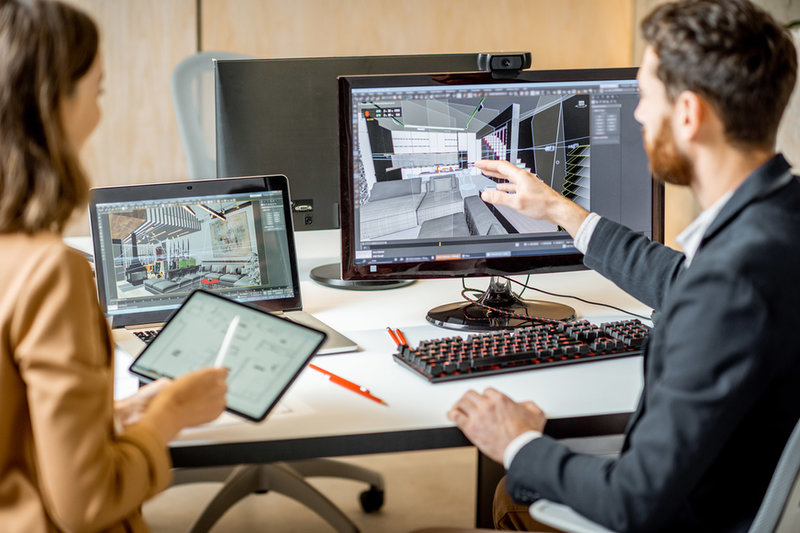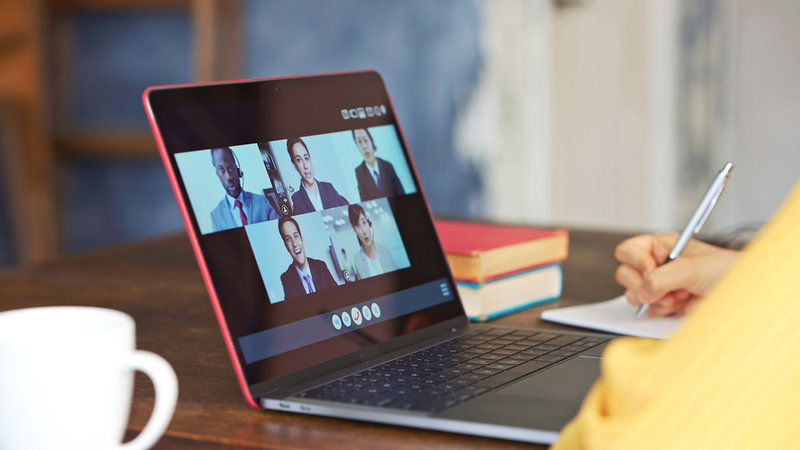Future of work
Remote, hybrid or office: how will architects work post-pandemic?
With and end to lockdowns on the horizon, companies are exploring their options for future ways of working. Luke Christou asks architects how they plan to do business in the wake of the pandemic, and what tools and technologies they rely on.

L
ast March, as the UK was thrust into lockdown with little notice, architecture firms were forced to adapt to a new way of working, acting fast to implement new tools and technologies to allow projects to continue remotely for the foreseeable future.
“Initially, it meant everyone dismantling their computers and desktop setups and taking them home in a taxi,” says Adrian Brewin of Reid Brewin Architectes. “Luckily, our existing infrastructure enabled everyone to connect to the network remotely via VPNs – although we did have to purchase some additional licences, and colleagues were forced to reorganise the layouts of their London or Parisian homes.”
The sector, reliant on collaboration between not only colleagues, but the various stakeholders involved in a project, did face some early difficulties. According to a RIBA survey published last April, just weeks after the UK entered its first lockdown, 30% of architects experienced communication difficulties as they adjusted to a new, remote way of working.
“At the beginning, there was a lot of sorting out technology and trying new platforms – plus endless calls with our IT consultant (who was amazing) to talk through a way of working with everyone,” recalls Pippa Nissen of Nissen Richards Studio.
However, a year on, architecture has adapted well. Despite early struggles caused by sluggish home internet connectivity, Nissen says the studio has, remarkably, not seen a significant dip in productivity.
Pippa Nissen, director of Nissen Richards Studio
Pippa Nissen, director of Nissen Richards Studio
Adrian Brewin, partner at Reid Brewin Architectes
Permanent remote working
Like most businesses, architecture firms have been heavily reliant on video conferencing software such as Microsoft Teams, Zoom, and Google Meet to share and collaborate over the past year.
“Every client has their own system with a different host of settings and controls, but these tools have become integral to everyone’s working day,” says Brewin.
Video conferencing tools have made the pandemic significantly easier for businesses to manage. By last summer, 82% of UK businesses were considering whether to stick to remote working practices permanently, according to video conferencing platform Whereby.
Yet, over time, demand for permanent remote working has fallen. By November, just 18% of respondents to a survey carried out by workplace analytics company Locatee said they wanted to work from home every day.
Last May, RIBA reported that 39% of architects said the pandemic was negatively impacting their mental health.
This is likely in part due to the lack of social interaction that remote working offers and the subsequent impact this has on mental health. Last May, two months after the UK entered lockdown, RIBA reported that one fifth of architects were experiencing isolation and loneliness, while 39% said the pandemic was negatively impacting their mental health.
“All in all – it was remarkably easy to adapt on the work and technology front and to adjust. Surprisingly so, in fact. But harder for us as human beings to not see each other in person,” Nissen says.
Both firms have taken steps to support those that have struggled throughout the lockdown. Reid Brewin Architectes has taken a proactive approach to checking in with staff beyond when ‘needs must’ for work-related tasks and has invited employees to come into the office on occasion when they are struggling. Likewise, Nissen Richards Studio has organised virtual tea parties and ‘buddy groups’ to offer opportunities for employees to socialise.
Yet, according to Nissen, the mental health of the firm’s employees has still been ‘severely tested’ by the pandemic. “Some people in the office have been living and working in one space, or have young children, or are carers,” she says. “All of these situations are just so difficult and I am in awe of how amazing everyone has been in keeping going.”
Returning to the office
Nissen Richards Studio has toyed with the idea of packing up its studio for good. This would, of course, remove a ‘huge expense’ for the London-based firm. However, the firm doesn’t believe the pros would outweigh the cons that it had already experienced.
“After all the pros and cons, we have firmly come to the conclusion that we want to go back to how we worked before,” Nissen says. “We are just waiting to see how and when it feels right and appropriate to go back to the office.”
Returning to the office could also be vital for the professional development of interns and those in the early stages of their careers.
Not only will returning to the office environment support the mental health of the firm’s employees, but it will also help to re-establish its creative process.
Likewise, with 49% of employees feeling that they aren’t getting enough training, coaching, and mentorship during the pandemic according to time management tool Doodle, returning to the office could also be vital for the professional development of interns and those in the early stages of their architectural careers.
“What people learn from having or overhearing conversations in the office is something that’s impossible to replicate,” Nissen explains.

Junior architects have suffered from a lack of training and mentorship while working from home.
It doesn’t have to be one or the other
According to a recent FlexJobs survey, 73% believe working from home has helped to improve their work-life balance. Yet, ccording to an Institute for Employment Studies study, 48% say they are working longer, more irregular hours. Evidently, working from home works for some, but not all.
Unsurprisingly, rather than full-time remote working, many employees want flexible working policies once Covid-19 subsides. In fact, almost half say they would seek a new job if they aren’t offered flexibility in the pandemic’s wake.
We will continue to be flexible with requests for remote working, but there will be a requirement to come into the office on a regular basis for team meetings and social cohesion.
Thankfully, lockdowns have shown firms that they can offer flexibility without output suffering. Both Reid Brewin Architectes and Nissen Richards Studio will continue to allow employees to work remotely as and when they need to. However, the office will continue to serve as a hub for employees to collaborate and socialise.
“We will continue to be flexible with requests for remote working, but there will be a requirement to come into the office on a regular basis for team meetings and social cohesion,” Brewin says.
“The social aspect of seeing work colleagues, and particularly communication across different teams and the sharing of ideas outside everyone’s immediate group has been missed.”

Firms will continue to rely on video conferencing technology to connect with international clients in the pandemic’s wake.
Technology will be a mainstay
The UK has set a June deadline for the end of Covid-19 restrictions. However, businesses will continue to face challenges such as continued disruption to international travel for a while yet. Even then, firms may continue to avoid international trips in order to tackle more long-term issues such as sustainability. This is one area where technology, implemented during the pandemic, will continue to support firms.
“Some international meetings which take lots of time in travel and have a bad carbon footprint will be much easier on Zoom,” Nissen points out.
However, the biggest revelation for Nissen has been Miro, a visual collaboration platform where architects and their clients can brainstorm and develop ideas on shared boards.
The firm has been using Miro as an online library, where everyone involved in a project can log in, upload, and comment. The tool has helped to keep clients in the loop, encouraged team members to share ideas, and helped the firm to keep track of changes to their 2D and 3D design files.
“When I discovered Miro, it was like a meeting of minds, a thunderbolt moment,” Nissen says. “Miro will forever be a part of our studio moving forwards.”
Main image: Rebecca Shorter, partner and construction law expert at White & Case